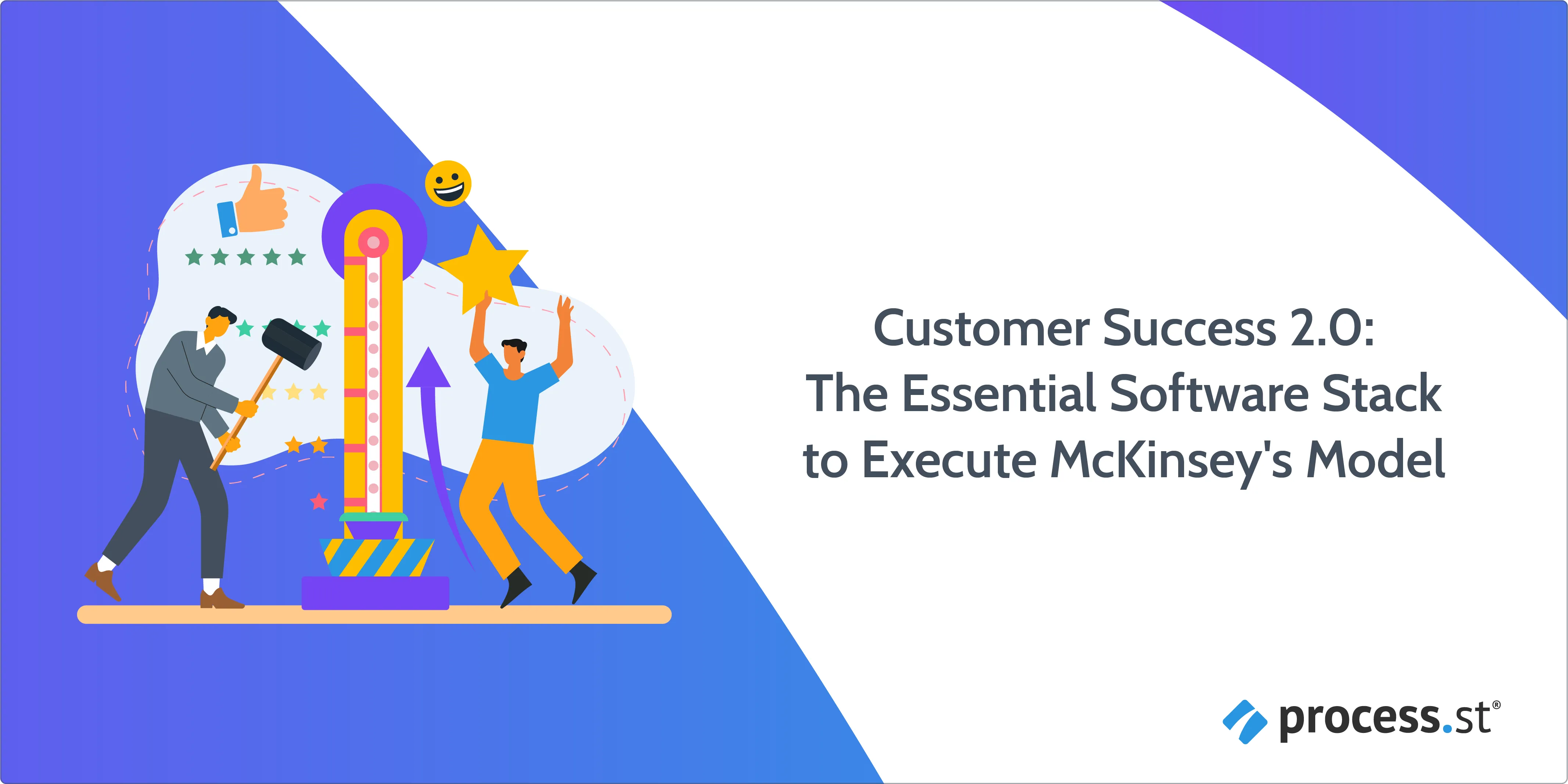Customer Success 2.0: The Essential Software Stack to Execute McKinsey’s Model
Blog: The Process Street Blog

Research shows that a 5% increase in customer retention rates can boost profits by 55%.
With this in mind, when it comes to customer success, it’s important you play your cards right to retain your customers.
In this Process Street article, we draw from McKinsey & Company’s post, Introducing customer success 2.0: The new growth engine. What’s more, thinking about customer success, we ask, how can you ensure you’re implementing customer success 2.0 strategies?
To help you get started, I’ve put together your essential software stack to execute customer success 2.0. Using this list, you can easily execute the five critical elements that’ll instill a customer success philosophy in your organization. But before all, let’s quickly recap the basics, and define the difference between customer success 1.0 and 2.0.
Click on the relevant subheader to jump to your section of choice, alternatively scroll down to read all we have to say.
- Customer success 2.0 vs. customer success 1.0
- Customer success 2.0 software stack to execute the McKinsey Model
- Comparing customer success 1.0 with customer success 2.0 in practice
Customer success 2.0 vs. customer success 1.0
Customer success 2.0 takes a holistic approach to customer success to cultivate a customer’s maturing use of a product/service. In essence, customer success 2.0 looks at how a business can help their customers grow with them to achieve their goals. Strategic objectives are laid out with the aim of propelling the customer’s business forward with product/service use versus driving this use for increased revenue.
In contrast, customer success 1.0 spends an inordinate amount of effort on labor-intensive adoption and reactive processes, with little or no regard to what the customer wants to achieve – aka, their goals.
Customer success 1.0 may achieve customer satisfaction, but that isn’t the same customer success. Customer satisfaction is momentary, whereas customer success is long-term.
- Customer success 1.0: Focuses on churn reduction and risk management. Emerged from SaaS companies focused on complex business applications.
- Customer success 2.0: Recognizes customer success as a growth engine used by companies across a range of business-to-business sectors to change the approach to customer life-cycle management.
Customer success 2.0 sounds all well-and-good in writing, but how do we translate this into an actionable framework?
If handled poorly, the transitioning to customer success 2.0 can undermine a customer’s trust in CSMs, and create the sense that they’re solely interested in increasing profits.
This is concerning considering that 89% of consumers will switch to a competitor following a poor experience; and these poor experiences will be shared with an average of 15 people. Getting customer success right, and not letting your customers down is therefore your utmost priority.
According to McKinsey & Company’s, to make sure customer success 2.0 is executed successfully, you need to apply the philosophy across your entire organization.
And for this, you’ll need to adopt these five critical elements:
- A unified go-to-market model
 : Customer success is integrated into sales activities, roles, incentives, and organizational approach.
: Customer success is integrated into sales activities, roles, incentives, and organizational approach. - A sustainable funding model supported by premium services
 : Funding models represent the intrinsic value of customer success activities and include a spectrum of free and fee-based services.
: Funding models represent the intrinsic value of customer success activities and include a spectrum of free and fee-based services. - The customer success talent engine
 : Clarity is given on the capabilities and intrinsic characteristics of top-performing, customer-success managers, with a comprehensive learning journey building internal capabilities. Career paths are given that offer growth and advancement.
: Clarity is given on the capabilities and intrinsic characteristics of top-performing, customer-success managers, with a comprehensive learning journey building internal capabilities. Career paths are given that offer growth and advancement. - Advanced analytics to predict customer behaviors and target customer segments
 : Analytics are used to identify and predict customer risks and opportunities, combined with activities proven to deliver customer success. Change management is used to promote the use of analytical insights in daily work processes.
: Analytics are used to identify and predict customer risks and opportunities, combined with activities proven to deliver customer success. Change management is used to promote the use of analytical insights in daily work processes. - Customer-success philosophy embedded across the organization
 : A cross-functional, comprehensive approach is used to deliver an optimal customer experience, with a customer-focused culture across the organization.
: A cross-functional, comprehensive approach is used to deliver an optimal customer experience, with a customer-focused culture across the organization.
So, how do you ensure these five critical elements are executed with effect?
Below I’ve listed the essential software stack you’ll need to execute the McKinsey Model, categorized in accordance to the critical element the software helps you achieve.
With that said, let’s jump straight into your customer success 2.0 software stack list.
Customer success 2.0 software stack to execute the McKinsey Model
McKinsey’s benchmark data suggests existing customers account for between 1/3 and 1/2 of total revenue growth, even for startups. To capture this revenue potential, you need to ensure your implementing the five critical customer success 2.0 elements with effect. The software stack listed below will help you do that.
Implement a unified go-to-market model using Process Street 
What is Process Street?
Process Street is a no-code, workflow management solution, built to document business processes, giving full transparency of operations to improve teamwork, reduce error and enhance efficiency.
How does Process Street support the unified go-to-market model?
To meet the unified go-to-market model, customer success managers need to be engaged with accounts providing product knowledge and domain expertise using their intimate understanding of each customer, and their objectives.
With Process Street, account information is stored in the cloud, to be accessed anywhere at any time by the relevant personnel. This means a given customer success representative can find the information they need – aka a customer’s goals, pain points, problems, and successes – from a single location. The information champions engagement, understanding, and account expertise are championed through secure, online documentation. What’s more, Process Street’s Task Permissions feature helps users control who can see what information for ultimate information security.
The unified go-to-market model also highlights the need to support collaboration between departments, especially sales, customer success, and service report teams. You need to clearly define how customer success will contribute to the growth of the organization across departments, and explain the role each will play in this while clarifying accountability through the sales lifecycle.
Process Street can assist you with this goal. You see, it’s easy to assign members to tasks in a given Process Street customer success workflow, using Process Street’s Role Assignments feature. These could be members from a separate team, bringing multiple teams together to work from a single process.
Members can collaborate from a single workflow via commenting on tasks and using Process Street’s Approvals features to streamline the decision-making process, giving tasks the go-ahead or rejection (with comments) as required.
“Process Street invites a great level of collaboration and document control to all workspaces.” – Gregory C, G2 reviews
Process Street’s Webhooks and Automation features can connect different departmental apps, sending customer success information from a workflow across departments and vice versa with a click of a button. In essence, Process Street acts as a grounding station, connecting departments and software, and providing full transparency over what work is being done by who and when.
Implement a sustainable funding model using Gainsight 
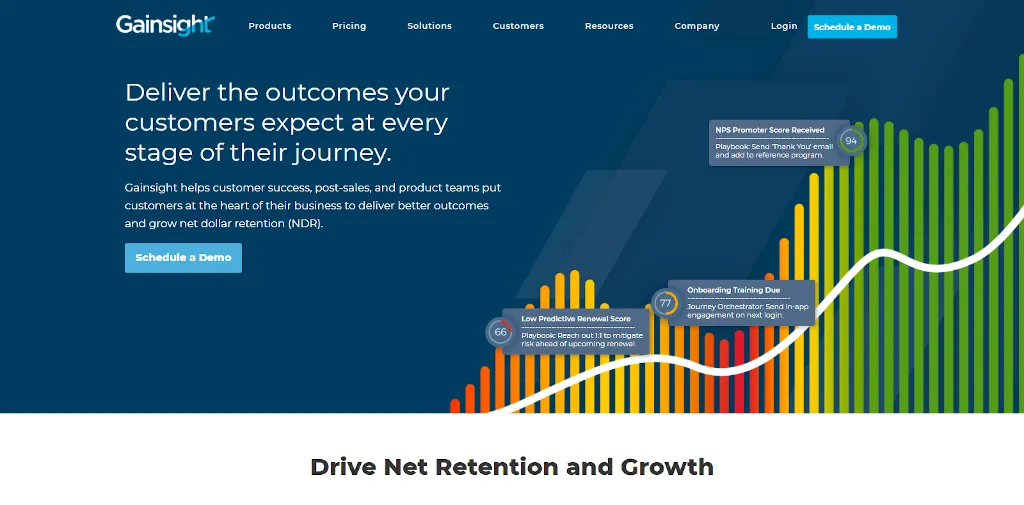
What is Gainsight?
Gainsight is a customer success platform that collects and stores customer data to give analytical insights, monitor customer feedback, engage with customers, and deliver customer success goals. Every activity the customer performs on the web is built into a database.
How does Gainsight support the sustainable funding model?
Leading companies will conduct detailed customer research and quantitative analysis when selecting a funding model. Customer pain points are mapped to prioritize the different customer needs and to determine which customer-success activities deliver the strongest returns.
For this, you need data. You need a way to test different offers using extensive market research. This is a data-driven approach for designing and pricing new offerings for vendors, maximizing customer value across all accounts while optimizing customer revenues, and building the investment case for customer success.
Gainsight is a platform designed for such testing. You can use the platform to extract data such as:
- Support ticket information
- Customer health scores
- Customer segmentation
- NPS surveys
- Customer health trends
- Customer lifetime value
- Churn rate
With this information, you can use the customer insight delivered to make informed strategic choices regarding the funding model you use. Solicit your customer’s feedback, measure their engagement level, and meet their expectations with your offerings.
“Gainsight helps our organization become dynamic. We have been able to change/re-structure/better test our organizational model, segments, health scoring, etc while gaining numerous operational efficiencies.” – Joseph L, Gainsight Reviews
You can also use Gainsight to identify new use-cases and orchestrate alternative pricing models that’ll deliver value. Using Giansight’s surveys, users can give product feedback. Use this feature in combination with Gainsight’s Timeline function to record the notes from one-to-one customer conversations. Then, pass this information to engineering, sales, and client outcome teams to develop new use cases.
Implement a customer success talent engine using Naturalhr 
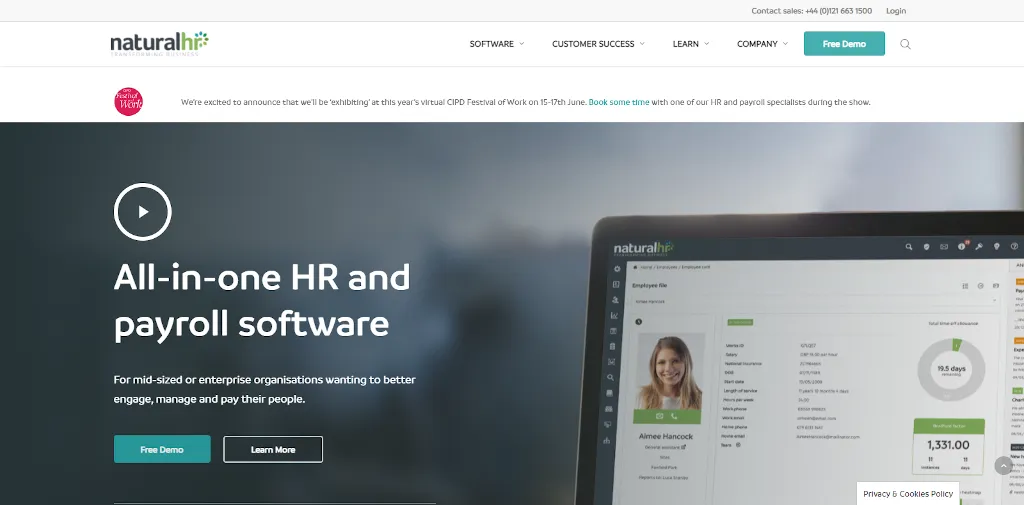
What is Naturalhr?
Naturalhr is a cloud-based human resource information system (HRIS) suitable for companies of all sizes. It’s software designed to help organizations with recruitment, onboarding, training management, absence management, performance management, employee information management, and reporting.
How does Naturalhr support the sustainable funding model?
Top talent is the backbone of any strong customer-success team, yet there’s stiff competition when it comes to sourcing and onboarding this talent. Thinking about the customer success manager role, there’s uncertainty around what skills are needed, with this being dependent on the product/service provided and the market context. For instance, one role may demand good vertical knowledge and relationship management skills, whereas another CSM role may emphasize good technical knowledge.
“Very good with extracting HR stats (i.e. diversity data, hiring/offboarding stats and staff demographics). Overall straightforward and easy to use system.” – Samar M, Capterra Reviews
To meet the sustainable funding model, four pillars to talent acquisition are required. I’ve explained these pillars in detail below, and how Naturalhr, as a software, delivers them:
- Identify
 : Link customer outcomes and goals with the skills and experience needed for your customer success managers. You can identify customer outcomes/goals using Gainsight to document and store this information securely using Process Street. Then, implement this information during your recruitment processes and create your best teams using Naturalhr. With Naturalhr, you can add notes to each candidate on your system, to distinguish their skills from the rest, then detail how these skills align with your customer’s goals.
: Link customer outcomes and goals with the skills and experience needed for your customer success managers. You can identify customer outcomes/goals using Gainsight to document and store this information securely using Process Street. Then, implement this information during your recruitment processes and create your best teams using Naturalhr. With Naturalhr, you can add notes to each candidate on your system, to distinguish their skills from the rest, then detail how these skills align with your customer’s goals. - Attract
 : Sieve through the talent pool to find top talent with the required skills, and identify untapped talent pockets using advanced analytical and external networks. With Naturalhr you can store and search applications with ease, using the filter feature to find candidates with specific skills and experience.
: Sieve through the talent pool to find top talent with the required skills, and identify untapped talent pockets using advanced analytical and external networks. With Naturalhr you can store and search applications with ease, using the filter feature to find candidates with specific skills and experience. - Build
 : Develop customized employee development pathways, taking the individual starting points into account. With Naturalhr, you can oversee the whole training and development cycle – from the first initial course to compiling feedback central for employee training. The competency tracking system means a library of competencies can be sourced and allocated against both job roles and employees, allowing gaps in development to be identified.
: Develop customized employee development pathways, taking the individual starting points into account. With Naturalhr, you can oversee the whole training and development cycle – from the first initial course to compiling feedback central for employee training. The competency tracking system means a library of competencies can be sourced and allocated against both job roles and employees, allowing gaps in development to be identified. - Retain
 : Create career paths that give meaningful rewards and progression for skill mastery. With the ability to oversee development cycles using Naturalhr, your top talent will always have a visual representation of where they are heading, and whether this aligns with their career goals. You can transform this developmental path into an actionable onboarding and employee development workflow using Process Street, or use one of our already pre-made, free onboarding templates, accessible from our template library.
: Create career paths that give meaningful rewards and progression for skill mastery. With the ability to oversee development cycles using Naturalhr, your top talent will always have a visual representation of where they are heading, and whether this aligns with their career goals. You can transform this developmental path into an actionable onboarding and employee development workflow using Process Street, or use one of our already pre-made, free onboarding templates, accessible from our template library.
Predict customer behavior and target customer segments using ChurnZero 
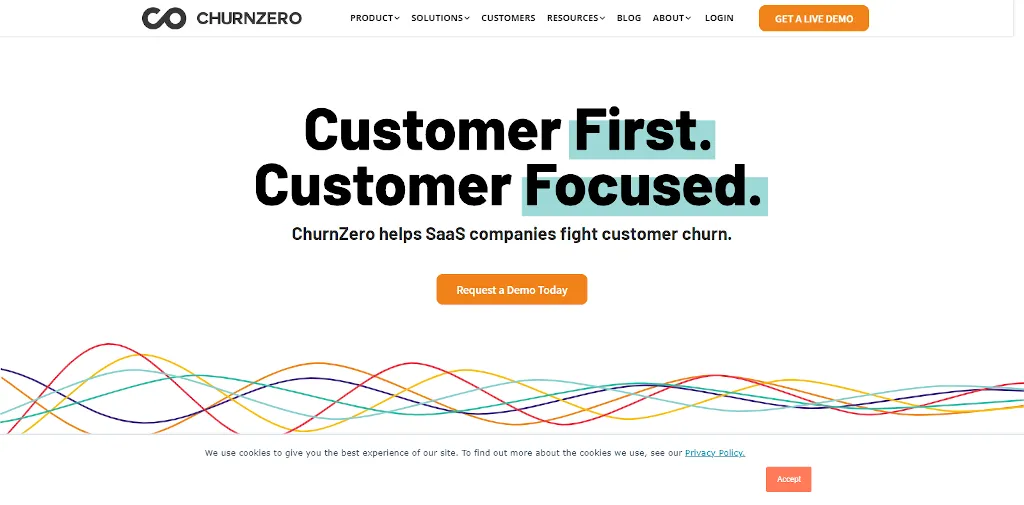
What is ChurnZero?
ChurnZero is a real-time customer success platform designed to help subscription businesses fight churn. The software integrates with CRM systems to help businesses understand how their customers use their product, assess their health, and their likelihood of renewal. This information is used to automate and personalize the customer experience journey through timely and relevant touchpoints.
How does ChurnZero support the sustainable funding model?
You’ll want to conduct a comprehensive assessment of your customer’s health to identify and predict risks and opportunities, aka churn and renewal/upsell options.
Some companies are reluctant to apply advanced analytics, as they think it will demand a large initial investment – especially true for businesses with poorly managed data or ones that still maintain legacy information systems.
“[ChurnZero allows] the customer success team to be proactive with accounts that may be declining in-app usage to try and re-engage. It also helps us identify who is using our product well and reach out to them to hopefully gain a reference or case study.” – James O’Neal, TrustRadius
ChurnZero offers an affordable, user-friendly means of actioning data to reduce churn and grasp opportunities. As a software, ChurnZero specializes in helping companies know its customers to prevent them from leaving.
Gainsight provides all-around analytics, essential for understanding the ins and outs of your customer accounts. ChurnZero hones in on account churn risk, helping the customer success team act proactively with accounts that are disengaging.
Though it’s all very well having the essential analytics to hand, the next step is converting analytical results into action. Many customer success managers and sales staff resist actioning analysis results due to mistrust, a lack of training, poorly designed workflows, and players not knowing where to begin. To prevent this lack of action, use Process Street to document the desired workflows and procedures based on your analyses.
Embed a culture of success using CultureAmp 

What is CultureAmp?
CultureAmp is a leading people & culture platform helping organizations take action to improve employee engagement, retention, and performance. It’s quick to deploy and provides continuous listening, feedback, and development tools throughout the employee lifecycle.
How does CultureAmp embed a culture of success?
Many companies are taking a journey-based approach to products and services, one that maps the desired customer experience and outcomes for the entire lifecycle. Yet, there’s a collective failing to understand how product management, marketing, sales, and service delivery decisions can have lasting implications on the customer experience.
“[CultureAmp] provides a heatmap based on the survey result, which can be configured as per different factors like location, team type, business function, etc. Provides deep insights into the people’s culture, performance, and engagement. Comes with a set of powerful analytics tools to give a deeper understanding. Machine learning can be used to predict future engagement and performance.” – Prathamesh S, G2 Reviews
In combat, companies need to take a different view on customer success, one that incorporates a shared philosophy for which every function is responsible. That is, organizations must embed a culture of success.
To instill this new philosophy, you must undertake the following critical tasks:
- Create clear accountability across multiple teams at each stage of the customer’s journey.
- Define the desired customer-success outcomes and how they’re linked to value. CultureAmp helps your teams understand how they’re linked to value creation, important for employee engagement.
- Implement processes that support cross-functional collaboration and learning. The insights gathered from your customer-success team can be shared with other teams.
- Empower a leader with oversight of the customer experience from end-to-end. Use data obtained from Gainsight and ChurnZero to assess your user experience from the initial contact they have with you, right through to the end customer journey goal. Then use CultureAmp to connect leaders with their teams to drive data-driven decisions.
- Ensure your company’s culture and all operations and processes focus on delivering value to the customers. CultureAmp improves employee engagement, retention, and performance under the company’s set of values. When it comes to customer success, this means your entire workforce will be working under the same customer success culture.
Comparing customer success 1.0 with customer success 2.0 in practice
Before closing off this article, let’s compare the two customer success types (2.0 and 1.0) to emphasize the need to invest in customer success 2.0.
Customer success 1.0 at Oracle
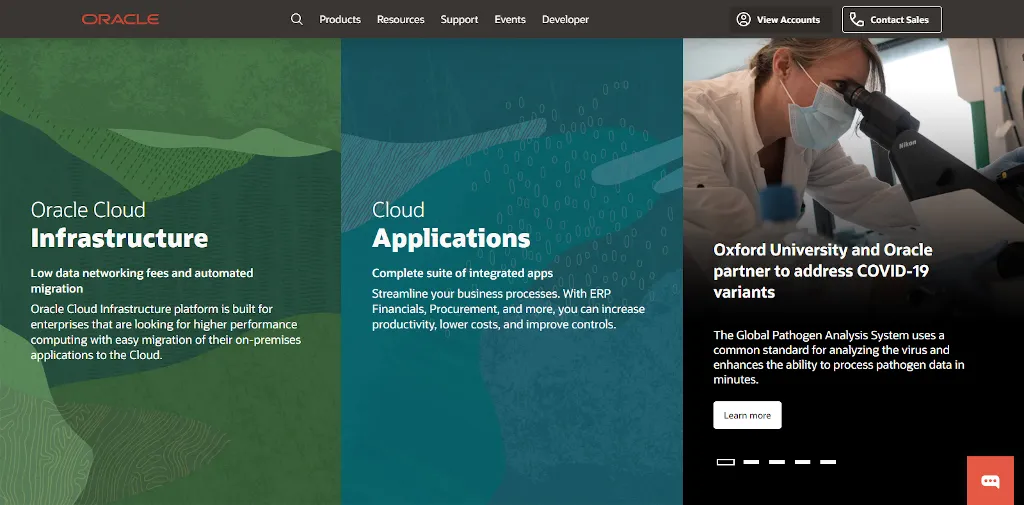
“What I truly dislike about Oracle is their ‘Business is war’ mentality. Oracle tries to dominate the market with aggressive sales practices, massive lock-in mechanisms, and above all litigations. Oracle depends on lock-in and their legal department. A modern company lives on quality and cooperation.” – Sebastiaan Peters, Quora
The database management company, Oracle, plays a reverse strategy to most vendors. Customer lock-in is considered an old enterprise strategy, where software was proprietary with a lack of open interfaces, meaning customers had to buy most of their gear from the same vendor.
Luckily, the situation has since changed, with open source software and APIs, empowering organizations to purchase the best software for the job. As a result, most vendors today are competing on quality and the overall customer experience.
Not Oracle. Customer lock-in is an explicit strategy used by the company. This strategy pays little regard to the customer’s goals, with the sole purpose of maximizing revenue.
While many competitors focus on innovation and customer value, these core values seem secondary for Oracle. Oracle as a business focuses on margin delivery, short-term profitability, and growth. These anti-customer strategies will only take the company so far – there will come a point where customers won’t put up with it anymore.
Another example of customer lock-in (a sign of customer success 1.0) is Apple – mobile communication and media device production company. I used to own an iPhone but switched to Samsung as Apple’s lock-in strategy was exasperating. I didn’t want to buy a specific Apple charger, headphone set, or download a specialized app store. Apple’s customer 1.0 strategy alienated me as a customer.
Customer success 2.0 at ServiceNow
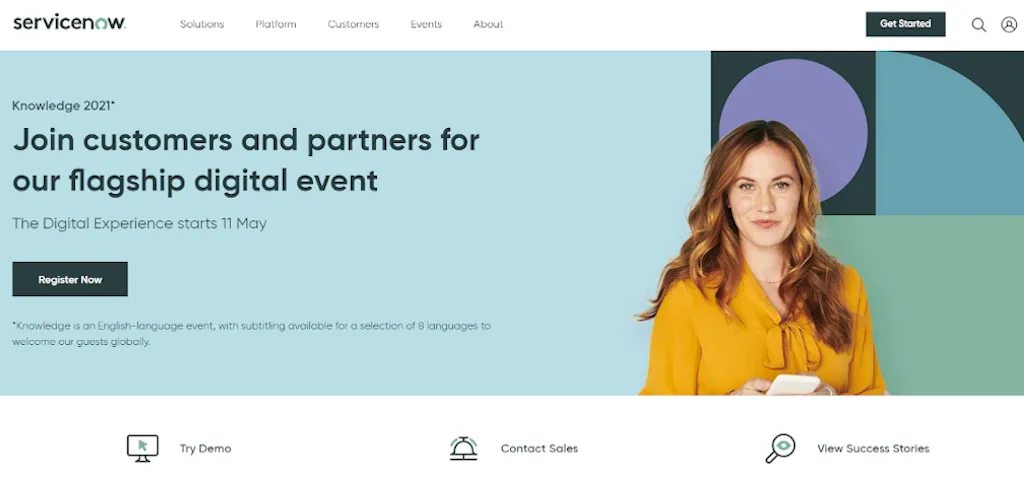
“What we’re going to do is put a little more focus on customer success, so that we’re capturing and documenting and codifying the business value that gets created.” – John Donahoe, Why Salesforce.com, Workday And ServiceNow Are Obsessing Over This New Cloud Metric
On joining the company, John Donahoe pledged to make customer success a top priority at ServiceNow. ServiceNow focuses on the customer lifestyle, from post-sale all the way through to renewal. Donahoe looked at how the customer could get maximum value from their product – you see, it’s all about the customer.
This change in perspective is a symptom of customer success 2.0, and with it, ServiceNow has grown 40%, with a record-setting stock price and a good shot to reach $2 billion in revenue.
The customer success 2.0 philosophy is embedded into ServiceNow’s value statement, which is:
“Take the right steps at the right time with a proven success plan, aligned to your priorities. Get to value faster with success experts to guide the way.” – ServiceNow, Customer Success Services
ServiceNow develops a success plan based on the user’s priorities. Its all about what value can we deliver our customers rather than, what value can we extract from our customers. As you can see, effective adoption of customer success 2.0 should run at the heart of a business, so much so that the organization’s value statement is built around customer success 2.0.
Customer success 2.0: Your new approach to customer success
Customer success 2.0 identifies opportunities to deliver more value to customers for companies to derive value in return.
Put in words, this sounds simple, but implementing customer success 2.0 is more complicated in practice. That’s why we’ve put together this article, giving you an essential software stack to make sure you triumph at customer success 2.0.
Put the customer first, and revenue growth will come later as a symptom of your change of focus.
How have you championed customer success 2.0? What software, tools, and techniques do you use to put the customer first? Let us know in the comments below!
The post Blog first appeared on Process Street | Checklist, Workflow and SOP Software.
